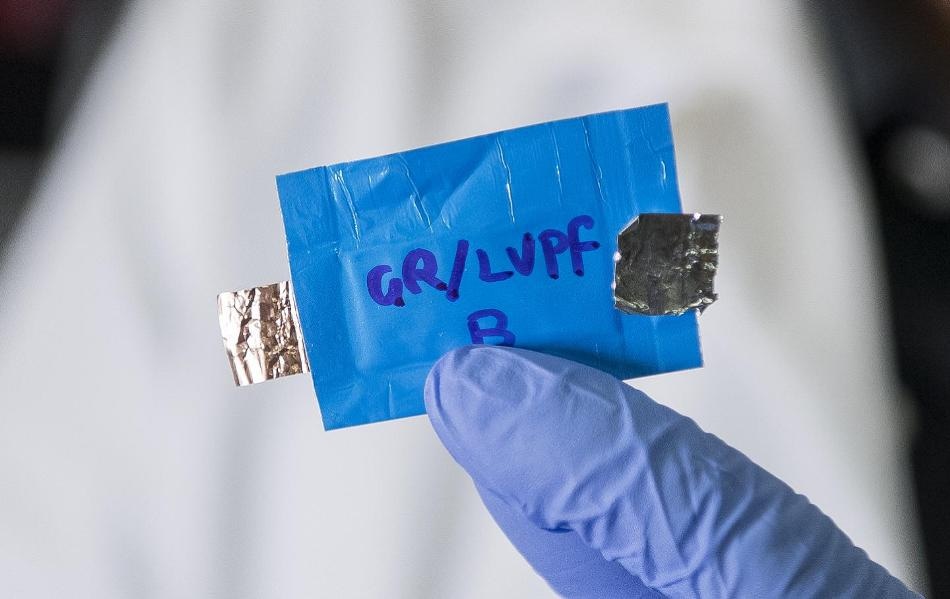Sep 7 2017
For the first time, Researchers at the U.S. Army Research Laboratory and the University of Maryland (UMD) have developed a unique water-based lithium-ion battery that does not explode.
The battery utilizes a water-salt solution as its aqueous electrolyte and reaches the 4.0 volt mark required for household electronics, for example laptop computers – without the risk of fire and explosion associated with certain non-aqueous lithium-ion batteries that are commercially available. The study has been reported in Cell Press's new interdisciplinary energy journal, Joule.
 These are four V Li-ion batteries assembled with water-in-salt gel electrolyte. (Credit: Jhi Scott, ARL Photographer)
These are four V Li-ion batteries assembled with water-in-salt gel electrolyte. (Credit: Jhi Scott, ARL Photographer)
This latest technology will bring the soldiers a, "completely safe and flexible Li-ion battery that provides identical energy density as the SOA Li-ion batteries. The batteries will remain safe - without fire and explosion - even under severe mechanical abuses," said Co-senior Author Dr. Kang Xu, ARL fellow who specializes in Materials Science and Electrochemistry.
In the past, if you wanted high energy, you would choose a non-aqueous lithium-ion battery, but you would have to compromise on safety. If you preferred safety, you could use an aqueous battery such as nickel/metal hydride, but you would have to settle for lower energy. Now, we are showing that you can simultaneously have access to both high energy and high safety.
Dr. Kang Xu, Co-senior Author and ARL Fellow in Materials Science and Electrochemistry
The study follows a 2015 research in Science (doi: 10.1126/science.aab1595) in which a similar 3.0 volt battery with an aqueous electrolyte was produced. However, the battery was prevented from attaining higher voltages by the so-called "cathodic challenge," wherein one end of the battery, produced from either lithium metal or graphite, is degraded by the water-based electrolyte.
In order to overcome this issue and scale up from three volts to four, Assistant Research Scientist at University of Maryland and First Author Chongyin Yang, created a new hydrophobic gel polymer electrolyte coating that can be easily applied to the lithium or graphite anode.
This gel polymer coating forces out water molecules from the area of the electrode surface, and when it is charged for the first time it decomposes and ultimately forms a stable interphase. This interphase is a thin mixture of breakdown products that keeps the solid anode and the liquid electrolyte separate from one another. Inspired by a layer created inside non-aqueous batteries, the interphase shields the anode from degrading side reactions, enabling the battery to utilize the preferred anode materials, such as lithium metal or graphite, and attain better cycling ability and energy density.
The key innovation here is making the right gel that can block water contact with the anode so that the water doesn't decompose and can also form the right interphase to support high battery performance.
Chunsheng Wang, Co-senior Author and Professor of Chemical and Biomolecular Engineering, A. James Clark School of Engineering, University of Maryland
When gel coating is added, the safety benefits of the novel battery are also improved compared to traditional non-aqueous Li-ion batteries. The gel coating also increases the energy density as opposed to all other recommended aqueous Li-ion batteries. Further, the inflammability of water-based electrolytes benefits all aqueous Li-ion batteries when compared to the organic solvents that are highly flammable and are used in non-aqueous batteries.
However, unique to this one is that even if a damage is caused to the interphase layer, for example if the battery casing was punctured, it reacts gradually with the lithiated or lithium graphite anode and prevents the explosion, smoking, or fire that could otherwise happen when the metal comes into direct contact with the electrolyte as a result of a damaged battery.
While the energy density and power of the latest battery are suited for commercial applications that are being served by more perilous non-aqueous batteries, some enhancements would make this battery even more viable. The Researchers, in particular, want to boost the number of full-performance cycles that can be completed by the battery as well as to lower material expenses wherever possible.
Right now, we are talking about 50-100 cycles, but to compare with organic electrolyte batteries, we want to get to 500 or more.
Chunsheng Wang, Co-senior Author and Professor of Chemical and Biomolecular Engineering, A. James Clark School of Engineering, University of Maryland
The team also noted that the electrochemical manipulations behind the leap from three volts to four have major significance within battery technology and beyond. "This is the first time that we are able to stabilize really reactive anodes like graphite and lithium in aqueous media," says Xu. "This opens a broad window into many different topics in electrochemistry, including sodium-ion batteries, lithium-sulfur batteries, multiple ion chemistries involving zinc and magnesium, or even electroplating and electrochemical synthesis; we just have not fully explored them yet."
According to Xu, the interphase chemistry has to be further improved before it can be commercialized on a large scale and also additional studies have to be carried out to scale up the new technology in large cells for testing. He added that with sufficient funding, the 4-volt chemistry could well be ready for commercializing in approximately five years.